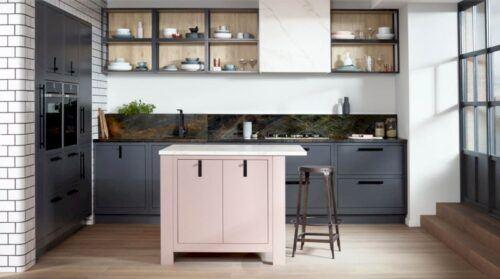How to Fit Kitchen Handles
25 November 2020 :: How To Guides & Cupboard Handles & Knobs
How to Fit Kitchen Handles
Fitting kitchen handles is a relatively simple DIY task and requires only basic tools.
What Tools Do I Need to Fit Kitchen Handles?
To fit kitchen door handles you will need the following equipment:
~ Drill
~ Drill bit
~ Masking tape
~ Screwdriver
~ Combination square
~ Tape measure
~ Pliers / Locking Pliers
~ Hacksaw
~ Optional Bluetack
~ Protective cover - cloth or towel
~ Block of wood
~ Pencil
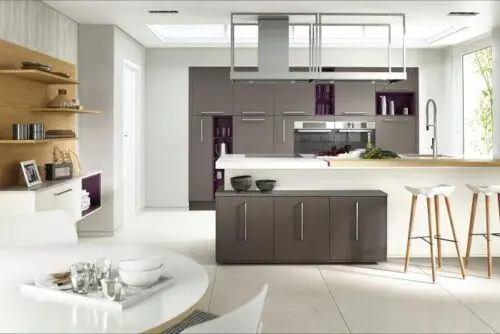
Where Should Handles be Placed on Kitchen Cabinets?
If you are replacing kitchen handles and reusing the old holes, then the decision on placement has been made for you. If you are fitting handles to new kitchen or cabinet doors, then you will need to select a location. As a rule of thumb, handles and knobs tend to be positioned on the opposite side of the hinge and toward the top of the door. On cabinets, you may find it easier to remove the door before you begin fitting the handle, though this isn’t always possible.
On kitchen drawers, a knob or handle is usually placed centrally or on the upper-centre section of the drawer. For wider drawers, you may choose to add a second handle. If you plan to fit two handles, divide the length of the drawer into thirds. Place the first handle on the border between the first and second third, and the second handle between the second and third section.
Deciding on the position can be a little difficult, but you can test out the handle placement using blue tack before you commit to the position. Once you have decided on the handle position, be sure to note down the measurements.
A word of warning - high gloss door finishes scratch very easily. If you have removed the protective film, then use masking tape on the door to protect the surface before testing out different locations.
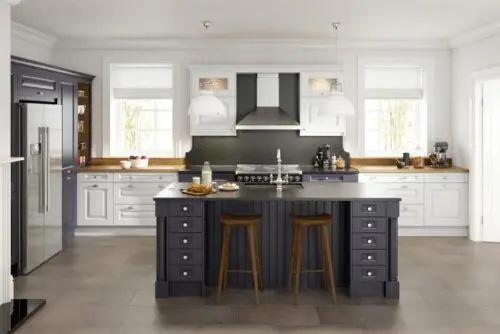
What size handle is correct?
Before deciding what size handle you’d like, you’ll need to decide whether to use knobs, handles or a combination of the two. If you choose to use bar pull handles, and your cabinets have existing drill holes, then you’ll obviously be limited to handles that fit the space.
On narrow kitchen cabinets, bar pulls may take up too much space. Using a smaller alternative, such as T-pull styles or kitchen knobs, might be more appropriate for the space. On larger cupboards, small handles or knobs can look dwarfed, so if your cabinets vary largely in size, consider selecting a range of handle sizes.
Measuring for Kitchen Handles
Kitchen cabinets and drawer handles will normally have two screw mounting points. You need to measure the distance between each of the holes and record the centre-to-centre measurement.
Measure out how far down the door you wish to place the handle. Mark the location of the top door handle hold and then using the measurement for centre-to-centre, mark the position of the second hole.
Now the door is marked out for drilling holes, DOUBLE-CHECK, everything. Hold the handles over the hole marks to check its position. Double-check that you have the door the right way up, and if you’ve removed the door, check that you’re working on the front face of the door, on the opposite side of the hinges.
This positioning procedure remains the same, regardless of whether a handle or knob is being fitted, though knobs may only require a single hole to be fitted.
With drawer fronts, measure the width of the drawer (normally 495mm or 595mm) and subtract the distance between the handle holes. Divide this by 2 and mark the drilling position in from each side.
Extractor doors and cabinets hinged from the top are exceptions. Here, you would normally position the handles on the bottom rail or bottom of the door.
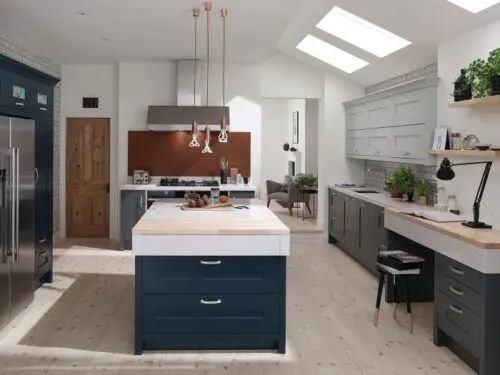
Drilling Holes in Kitchen Cabinets
Before you begin drilling, there are a few points to consider. Choose a drill bit that’s just a small amount bigger than the screw supplied with the handle/knob. If possible, select a wood drill bit. These have a very sharp point that makes positioning easier. However, a normal drill is fine.
Before placing your kitchen door or drawer front on a flat surface, ensure you have a towel or other fabric on the surface to avoid scratching.
Always put a block of wood or MDF behind your doorhole position. This prevents the drill from splitting the back of the door. If you’re using your kitchen worktop as a workbench, be very wary of how far through you drill!
Place the drill bit in the drill and ensure it is tight. Position the drill bit onto the hole positions marked out earlier. Double-check these are the right hole positions, then keep the drill vertical and slowly start to drill. Don’t go too fast, apply too much pressure or bend the drill, as this risks the drill snapping in the hole. Once you have drilled the hole, repeat for any second handle holes.
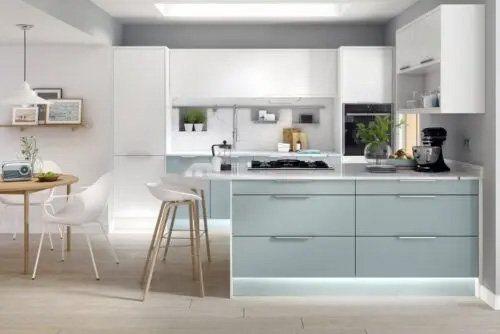
Add the Screws to the Kitchen Handles
With the masking tape and any protective film removed, you are now ready to fit the handles. Often, kitchen screws are longer than necessary and may need to be trimmed down to the correct length. Modern screws have marked areas with no thread on them for you to cut or break the screw to the right length.
Push the screw through the drilled hole and test fit a handle. If there is a gap left between the door/drawer front and the handle, you will need to trim the screw-down by the additional length. If this is the case, measure the gap and then remove the handle. Place masking tape on the screw and mark how much you need to trim the screw. You should find that the trim length aligns with a non-threaded area on the screw. In this case, you can use pliers to bend the screw back and forth to snap the screw to length. If you have a fully threaded screw you will need to use a hacksaw or angle grinder to trim it. Using a vice to hold the screw securely is recommended, but you can use pliers / locking pliers.
With the screws trimmed to length, fit the handles in place and be careful not to over-tighten the screws.
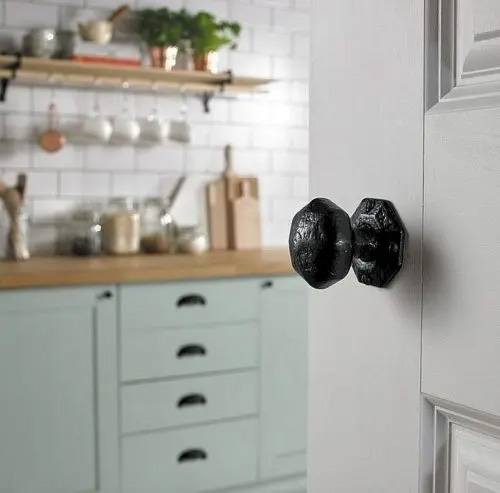
Where Should Kitchen Door Handles be Positioned?
Are you adding new door handles on rose or backplate or new doorknobs to the passage doors leading into the kitchen as well? Standard passage doors leading into a kitchen have a height of 78’' (198.12cm), with door handles typically placed around 39’’ (99.06cm) (approximately half of the height of the door) from the floor. The actual placement of the panel depends largely on the style of the door. In a quad-panelled door, for example, the handle is usually placed between the upper and lower panels, whereas a rustic-styled, ledged door may allow for more flexibility.
Our range of Jigtech handles is available to provide hassle-free fitting. With fast-fit roses and no wood screws required, Jigtech handles are simple and quick to fit.
Once you’ve refitted the doors, it’s time to stand back and admire your handy work!
Be the first to hear about promotions, price drops and discounts on our kitchen handles by signing up to our newsletter today!
If you encounter any issues along the way, feel free to pick up the phone and speak to the experts in door handles. We’re here to help with any handle related query so contact us today on 01228 516516 or email us at sales@morehandles.co.uk.

